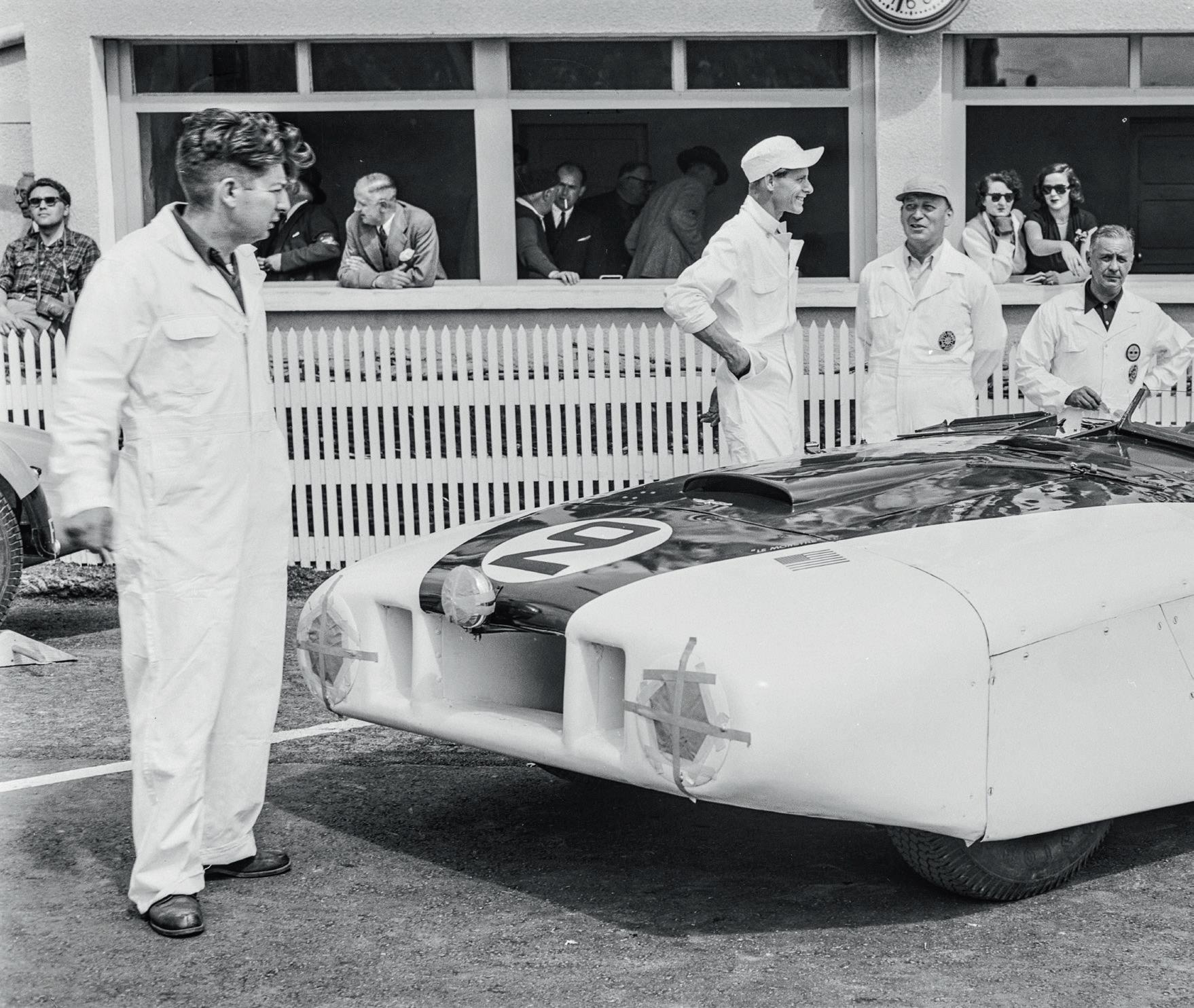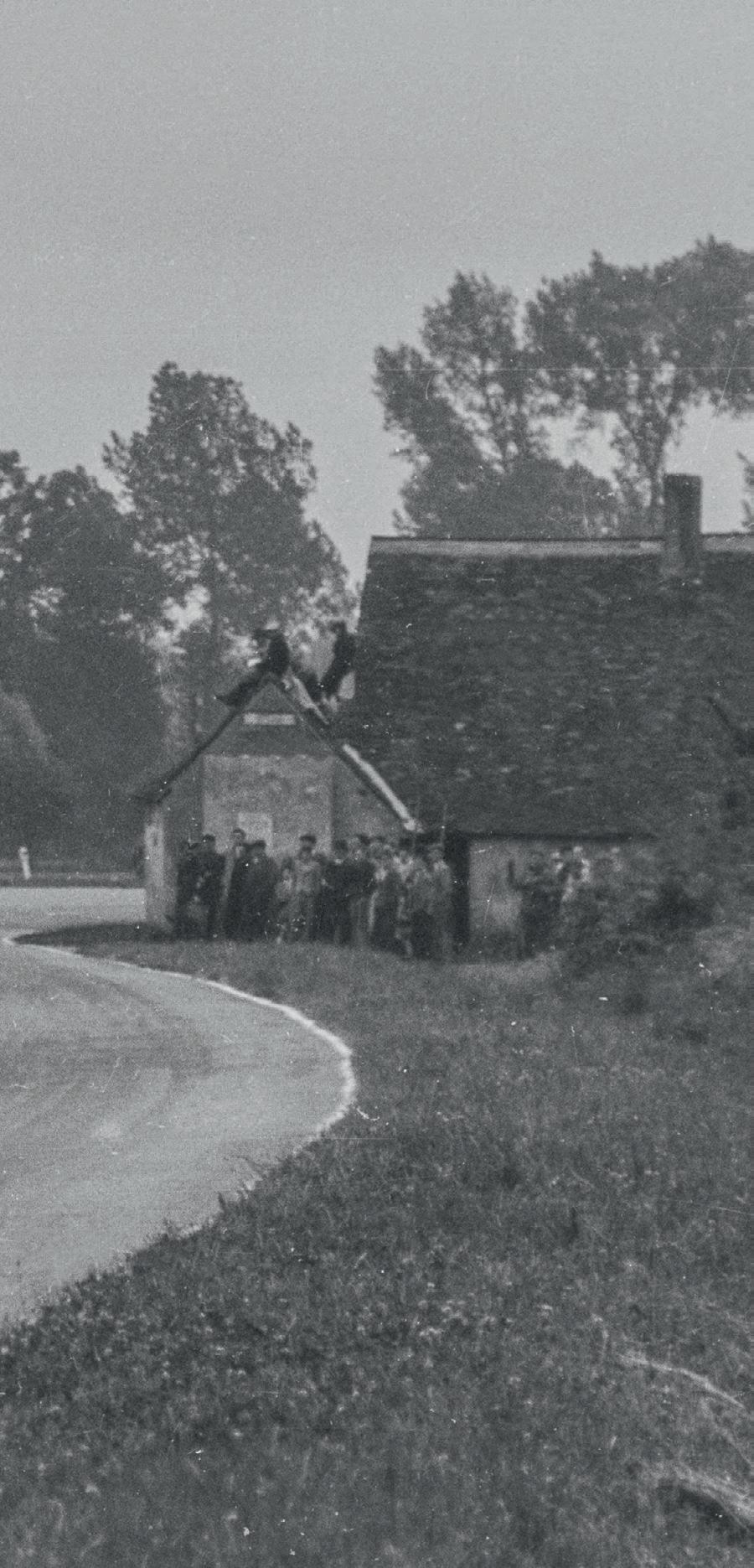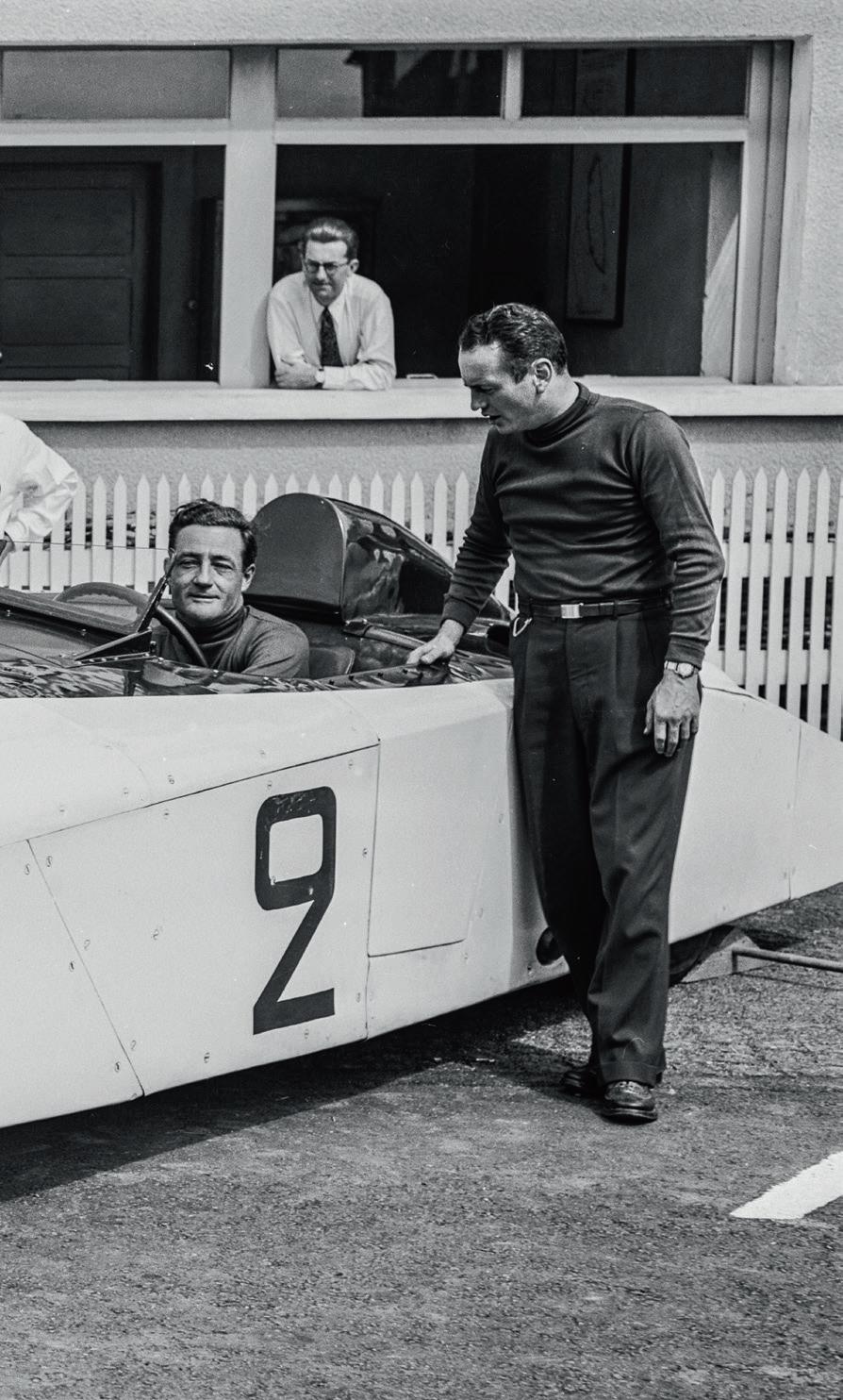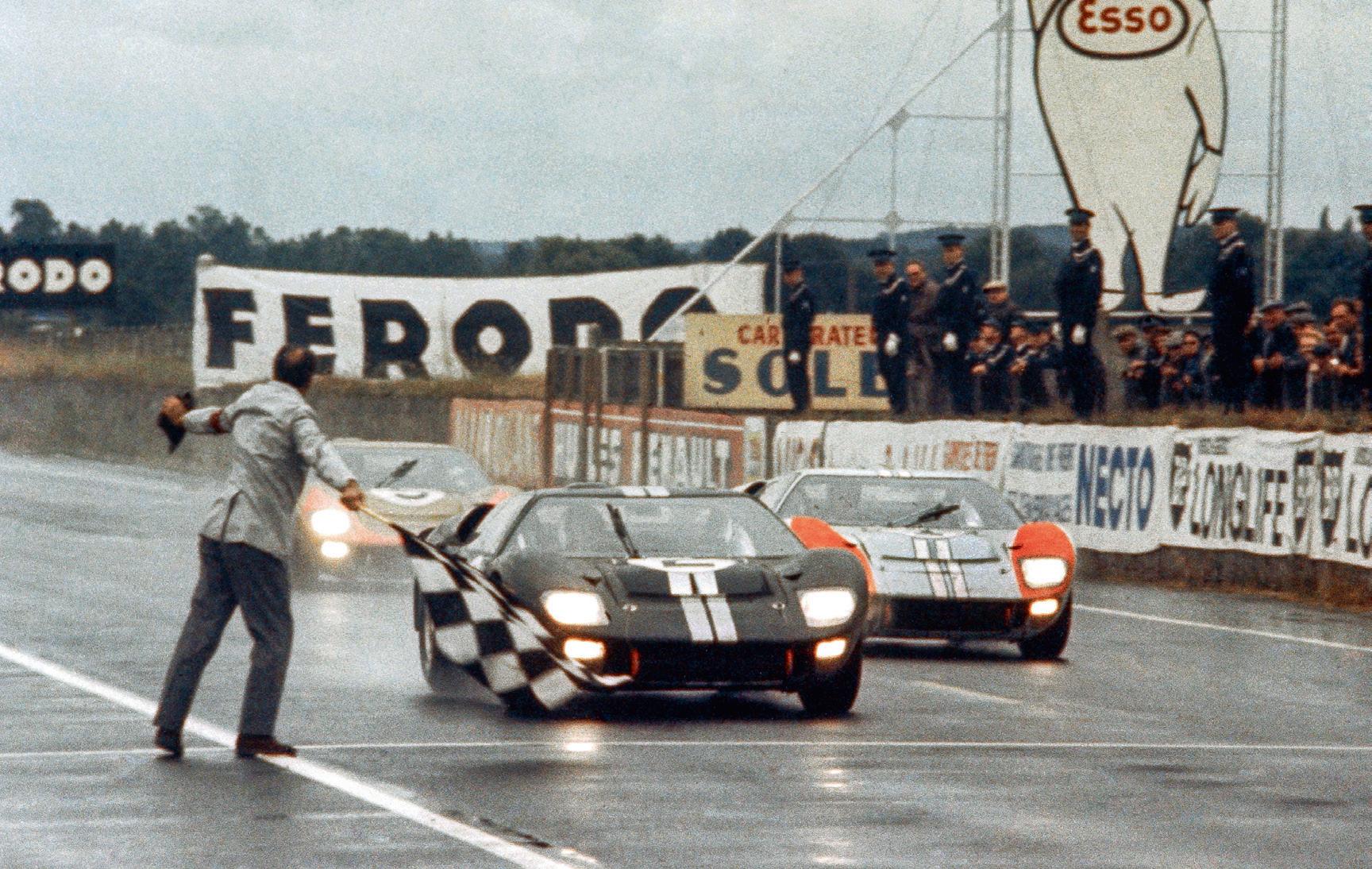
10 minute read
‘THEYANKSARECOMING!’
In100years,anAmerican
WORDS HARRY HURST
“Before we went over… only a handful of Americans had tried Le Mans… American cars had been popular with European drivers during Le Mans’ early days, but I was determined to win it with American drivers and an American machine.”
Briggs Cunningham
IN JUNE 1951, ONLY SEVEN YEARS FROM the day the Americans landed on Omaha Beach, a huge contingent of race cars, mechanics and support vehicles from the Cunningham Motor Company of West Palm Beach, Florida, arrived at the small town of Le Mans, France, to represent America in the 24-hour event held there. A decade later, the armada from the Ford Motor Company would dwarf Cunningham’s efforts. It’s not that much of an exaggeration to say that the Blue Oval’s efforts to win this race required amounts of money, manpower and material on a scale not seen since D-Day.
Over the 100 years of the running of the legendary Le Mans 24 Hours, hundreds of American drivers and American-built cars have competed in this prestigious event. But despite their heavy involvement, an American car piloted by American drivers has won the race only once – in 1967, when Dan Gurney and AJ Foyt took their Dearborn-designed and -built Ford MkIV to the victory lane.
Why has an American car with American drivers won Le Mans just once? And even more, why has America had such an on-again, offagain relationship with what is considered the world’s greatest single-day sporting event?
The oft-repeated axiom that ‘the first auto race was held on the day that the second automobile was built’ has some truth. The first organized event was held in 1894 from Paris to Rouen. As the auto industry grew around the world, reliability became a primary attraction for buyers, and racing became a way for manufacturers to demonstrate their superiority. ‘Race on Sunday, sell on Monday!’ was true right from those very early days.
While the first 24-hour race at Le Mans was 100 years ago this June, the area had a long association with automobiles, speed and Americans. Wilbur Wright made his first European demonstration of his flying machine at the airstrip outside this industrial city. And the first race to use the moniker ‘Grand Prix’ was held on local roads in 1906.
Although the French Grand Prix was interrupted during World War One, it resumed in 1921. Wanting to show the world that America produced the best cars, brothers Fred and Augie Duesenberg, both naturalized US citizens, built four machines to compete at the Le Mans circuit. Duesenbergs were potent racing models in the States, with their 183ci engines. But European cars at the time had significantly larger and more powerful motors. To give the Duesenbergs an ‘unfair advantage’, as another American outfit would later claim, these automobiles were equipped with hydraulic brakes on all four wheels – a first for any car. This gave them a significant edge in the corners and helped bring Jimmy Murphy the win. It would not be until four decades later when another American, driving an Americanbuilt car, would win an international GP race – Dan Gurney in his Eagle in 1967 at Spa.
The Duesenbergs that competed at the 1921 French GP, as well as the other machinery in the competition, were purpose-built race cars. In 1923, a group organized under the L’Automobile Club de l’Ouest proposed a 24-hour event strictly for production models at Le Mans. These had to be standard versions of cataloged cars, and originally there needed to be 30 identical examples present at the race for verification.
The rationale for this was that only by competing against each other could the technology and quality of production cars be improved. One of the organizers, Emile Coquille, remarked that if motorists were to drive at night, it would be a good thing to hold a race “for the sole reason of making manufacturers perfect their electrical apparatus”.
The idea of 24-hour races, or ‘twice-aroundthe-clock endurance derbies’ as they were called, actually originated in America. As early as 1905, 24-hour events were being held in Ohio and the Point Breeze district of Philadelphia. But auto competition in the US quickly moved to horse-racing venues, and the cars were transformed from production-based models to pure motor-sport machines. Some of the early proving grounds, such as the Indianapolis track, adapted over to racing with admission-paying spectators. There was little interest in this country in competition on public roads using production cars. Indeed, there was virtually no road racing in America until after WW2.
But ‘stock car’ events did exist in the US, albeit they were not nearly as popular as the purpose-built racers that ran at Indianapolis and board tracks across the country. One early proponent of stock cars was Fred Moskovics, president of the Stutz Motor Company. Stutz had been one of the few American marques to consider entering the Le Mans 24 Hours, already established by the late 1920s as the most important sportscar race in the world. (A Model T Ford ran in the first Le Mans, but was not a factory effort.) The Stutz Black Hawk Speedster was a potent road car, with 115bhp and a streamlined body. Moskovics had consulted with Ettore Bugatti on its cylinder-head design, and word reached Europe of the potency of this car to break the Bentley domination in the late 1920s.

Moskovics sent a four-seat (a contemporary rules requirement) Black Hawk to the 1928 Le Mans, to be driven by two Frenchmen who had experience in the event. The Stutz showed its potential by finishing a close second to the 4½ Litre Bentley of Woolf Barnato and Bernard Rubin. Extending America’s success were two Chrysler 72s, coming in third and fourth.
Stutz returned the next year with a trio of 6½-liter, supercharged Model M Le Mans fourseaters. Keeping this from being a pure all-US venture was the need to have them entered by two French teams and a single British. One of the cars – now in the Simeone Museum in Philadelphia – led the race for a significant time before succumbing to a split gas tank.
Also in the 1929 event was another US car, a Du Pont Model G. This was the first entry of an American automobile with American drivers: Charles Moran and the New York Du Pont dealer Alfredo Miranda, the latter of whom was born in Mexico but held dual citizenship. The car they brought was a beautiful four-seater with a 322ci Continental engine boasting 125bhp. Starting second on the grid, Moran had just settled into a pace for the long race when one of the 120lb sandbags required as ballast to replicate passengers came loose, broke through the floorboards and bent the driveshaft.
By the early 1930s, the world had fallen into depression and America entered a period of isolation. Racing in this country was almost exclusively on oval tracks, except for a small contingent in the Northeast. Avid road racers, including the Collier brothers – Barron Jr, Miles (who raced an MG at Le Mans in the 1930s, the fourth American to enter) and Sam – formed the Automobile Racing Club of America. ARCA held several events every year from 1930 to the onset of WW2. They originally took place on the driveway of the Colliers’ estate, Overlook. These were the only instances of road racing in America at this time, featuring the first appearances of MG,


Alfa Romeo and Bentley in this country.
One of the most avid competitors in the ARCA events was Briggs Swift Cunningham. Briggs came from a wealthy Cincinnati banking family; his father was an early investor in a local soap company, Procter & Gamble. Cunningham was a ‘sportsman’, not a playboy as many with his wealth would choose to be. He felt it was his obligation to use his fortune to represent America in international competition. Probably the high point for his efforts was winning the America’s Cup in 1958 with the 12-meter yacht Columbia.
But his real passion was racing sportscars, and his ultimate goal was to win Le Mans with a US team. He began this quest in 1950 by entering two modified Cadillacs: one with a stock body, and the other with aerodynamic panels that were so radical it was nicknamed ‘Le Monstre’ by the French. The two cars finished in tenth and 11th places. Encouraged, Cunningham enlisted the support of two experienced racers, Phil Walters and Bill Frick, to launch the Cunningham Motor Company in West Palm Beach. The first car they built, the C-2R, had prodigious power from its Chrysler Hemi engine, but was very heavy at 4000lb.
Cunningham entered three C-2Rs in 1951, and one, driven by Walters and John Fitch, led for six hours until it had bearing issues. The other two were involved in accidents due to heavy rain. The team returned to Florida and started work on the C-4R, a car that would go on to win 74 percent of its starts in American races, including the 1953 Sebring 12 Hours, and finish an astounding 84 percent of those it entered.
But despite this record of reliability, two of the C-4Rs entered at Le Mans in 1952 did not finish. A third came in fourth overall. The next year, all three Cunninghams finished in the top ten, including one of the new C-5Rs. In 1954, the swan year for the C4-R, a Cunningham came in third overall and won its class, tying the team’s best finish at Le Mans.
After 1954, Briggs chose to pursue his goal of an outright win at Le Mans with cars from other manufacturers: Jaguar, Chevrolet and
Maserati. Unfortunately, none was able to deliver the holy grail of a Le Mans trophy to him.

Road racing grew quickly in America after the war, led by the running of the Sebring 12 Hours. Many American drivers were becoming international names, including Richie Ginther, Dan Gurney and Phil Hill. The last of these starred at Ferrari, and won Le Mans in 1958, ’61 and ’62, along with the 1961 Formula 1 World Drivers’ Championship. Another was a chicken farmer from Texas named Carroll Shelby, who got a ride with the Aston Martin sportscar team and won the 1959 Le Mans.
Shortly after his victory, Shelby was forced to retire from racing due to heart issues, and instead he turned his attention to his vendetta to beat Ferrari at Le Mans. In 1962, he began building his Ford V8-powered Cobra, which fired the first salvo in the Ford vs Ferrari war. In 1964, his Cobra Daytona coupes took their class at Le Mans, and in 1965 the Manufacturers’ Championship, but these cars were not capable of winning Le Mans outright.
At the same time Shelby was developing his Cobras, Blue Oval executives were involved in extensive discussions with Enzo Ferrari to create a Ford-Ferrari entity to both race and build production machines. Claiming the lawyers’ demands were too restrictive, in May 1963 Enzo pulled out of negotiations. But Roy Lunn, a British engineer who’d come over from Ford in England and had racing experience, was ready with a contingent plan within days.
Lunn’s team had produced a mid-engined concept vehicle the year before, the Mustang I. This team began work on a sports racer that could conquer Ferrari at Le Mans; an event the Italian company had won over the past three years, and six times since 1949. The new car, dubbed the GT40 due to being only 40 inches high, was the first race machine to be designed with computers, and it was capable of speeds approaching 200mph on the eightmile Mulsanne Straight at Le Mans.
The GT40 showed promise in 1964, but did not finish a race, much less win. At Le Mans, the cars were very fast yet the transmissions
ABOVE Cobra Daytona took its Le Mans class in 1964, as well as the ’65 Manufacturers’ Championship.
‘The Cobra Daytona coupes – the first salvo in the Ford vs Ferrari war – were not capable of winning Le Mans outright’ were a weak link. Ford returned in 1965 with the MkII, a 427ci monster that was even faster but had not had sufficient development. A Ferrari again came in first, although this time it was an entry from Luigi Chinetti’s North American Racing Team that was co-driven by countryman Masten Gregory. This was the last time Ferrari won Le Mans. Interestingly, Chinetti himself technically was the first American to score gold at La Sarthe, since he was in the process of becoming a naturalized citizen when he won in 1949, delivering the inaugural Ferrari victory at Le Mans.
After the 1965 event, Henry Ford II had given the Blue Oval executive in charge of the racing effort, Leo Beebe, a note saying: “We better win!” and a blank check with which to accomplish the mission. Over the next year, the MkII was thoroughly tested and refined using computer simulations to run the drivetrain through the 24-hour race until it could perform flawlessly. Weak points, especially the transmissions and brakes, were addressed and workable solutions found. By the 1966 event, the MkII had demonstrated its dominance with wins at Daytona and Sebring.
At Le Mans, Ford entered no fewer than eight MkIIs: three each for Shelby and HolmanMoody, and two for the British Alan Mann team. The drivers were an eclectic mix of Americans (Dan Gurney and Mario Andretti),
New Zealanders (Chris Amon, Denny Hulme and Bruce McLaren) and other nationalities. Initially the American team of Gurney and Jerry Grant led, and then Ken Miles and Hulme, but it was the MkII of Amon and McLaren that determined the winner amid a controversial finish.
Also entered for the first time at Le Mans was another American team, the Chaparrals, built by Texan Jim Hall and driven by Phil Hill alongside Jo Bonnier of Sweden. They would not finish in 1966, but continued to campaign into the ’67 season. With their limited resources compared to Ford and Ferrari, none of their entries was able to finish at Le Mans, although they did win at the Nürburgring in 1966.
In 1967, Ford’s desire for an all-American win at Le Mans finally came to fruition. Dan Gurney and AJ Foyt were on the victory podium spraying Champagne, a tradition Dan inaugurated. The winning car was the GT40 MkIV, a completely new design, engineered and built by Kar-Kraft in the US. Not since Jimmy Murphy in his GP Duesenberg had American drivers won at La Sarthe driving an American car.

The GT40 went on to win Le Mans in 1968 and 1969 wearing the Gulf colors and prepared by John Wyer, the original Ford racing manager. But these did not have American drivers. Indeed, no all-American car-and-driver teams have seriously vied for the overall win at Le Mans since 1967. Corvette certainly has had a strong presence there for several decades, taking numerous GT class wins. Perhaps this year, with Cadillac and Glickenhaus both competing for top honors, we will at least see an American car win again. But, why has it taken more than 50 years to witness an effort this strong?
The late collector/historian Fred Simeone devoted a section of his world-famous museum to showcasing America’s infrequent efforts at Le Mans, with examples of Stutz, Du Pont, Cunningham and Ford cars that competed in the 24-hour race. In his book, The Spirit of Competition, he observed: “Unquestionably, the Le Mans 24 Hours gradually developed from its 1923 beginnings as a sportscar race into the Olympics of the sport. Always attracting international attention, and the highlight of the European racing calendar, a victory in this event heralded unparalleled approbation.
“Why then would not the greatest automotive-manufacturing nation want to compete and show the superiority of its vehicles? There is no answer.”










